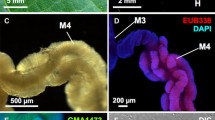Summary
C14-labelled bacteria,Serratia marcescens, were injected into the hemocoel ofHelix pomatia, and the distributions of bacteria and their breakdown products were followed by killing snails and measuring the C14 levels in the various tissues of the body. During rapid clearance from the hemolymph the bacteria accumulate in all tissues which have a rich hemolymph supply, but the digestive gland appears to be the most important organ in clearance (Figs. 1, 2, 3). Over the 15-day period studied, the bacterial C14 is mostly retained within the snail, becoming more evenly distributed throughout the tissues. Fecal C14 remains at a low level. These data are interpreted as indicating that a large proportion of bacterial C14, or its breakdown products, is incorporated into the snail tissues.
Similar content being viewed by others
References
Bayne, C. J.: Internal defense mechanisms ofOctopus dofleini. Malacol. Rev.5, In press, (1973a)
Bayne, C. J.: The immediate fate of bacteria entering the land snailHelix. Contemp. Topics in Immunobiology4, In press (1973b)
Bayne, C. J., Kime, J. B.: In vivo removal of bacteria from the hemolymph of the land snailHelix pomatia (Pulmonata: Stylommatophora). Malacol. Rev.3, 103–113 (1970)
Brown, A. C.: Elimination of foreign particles by the snail,Helix aspersa. Nature (Lond.)213, 1154–1155 (1967)
Cheng, T. C.: Immunity in mollusca with special reference to reactions to transplants. Transplant. Proc.2, 226–230 (1970)
Chiarandini, D. J.: A saline solution for pulmonate molluscs, Life Sci.3, 1513–1518 (1964)
Gushing, J. E., Evans, E. E., Evans, M. L.: Induced bactericidal responses of Abalones. J. Invert. Pathol.17, 446–448 (1971)
Gilbertson, D. E., Etges, F. J.: Haemagglutinins in the haemolymph of planorbid snails. Ann. trop. Med. Parasit.61, 144–147 (1967)
McKay, D., Jenkin, C. R., Rowley, D.: Immunity in the invertebrates. I. Studies on the naturally occurring haemagglutinins in the fluid from invertebrates. Aust. J. exp. Biol. med. Sci.47, 125–134 (1969)
Pauley, G. B., Krassner, S. M., Chapman, F. A.: Bacterial clearance in the California Sea Hare,Aplysia californica. J. Invert. Pathol.18, 227–239 (1971)
Reade, P. C.: Phagocytosis in invertebrates. Aust. J. exp. Biol. med. Sci.46, 219–229 (1968)
Stuart, A. W.: The reticulo-endothelial apparatus of the Lesser Octopus,Eledone cirrosa. J. Path. Bact.96, 401–412 (1968)
Tripp, M. R.: Defense mechanisms of mollusks. J. reticuloendoth. Soc.7, 173–182 (1970)
Wang, C. H., Willis, D. L.: Radiotracer methodology in biological sciences, 382 p. New Jersey: Prentice Hall Inc. 1965
Author information
Authors and Affiliations
Additional information
I am most grateful to Gene Lindsay who sent theHelix from Michigan. Tedious technical procedures were carried out by Anita Hutchins and Karen Miller. The research was supported by a grant from the National Science Foundation, GB 29315. For informative discussion I am grateful to my colleagues F. P. Conte, Leo Parks, G. H. Wang, Don J. Reed and V. J. Brookes.
Rights and permissions
About this article
Cite this article
Bayne, C.J. Molluscan internal defense mechanism: The fate of C14-labelled bacteria in the land snailHelix pomatia (L.). J. Comp. Physiol. 86, 17–25 (1973). https://doi.org/10.1007/BF00694474
Received:
Published:
Issue Date:
DOI: https://doi.org/10.1007/BF00694474




